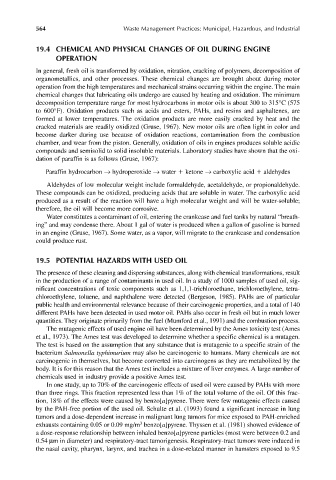Page 593 - Materials Chemistry, Second Edition
P. 593
CAT3525_C19.qxd 1/28/2005 5:05 PM Page 564
564 Waste Management Practices: Municipal, Hazardous, and Industrial
19.4 CHEMICAL AND PHYSICAL CHANGES OF OIL DURING ENGINE
OPERATION
In general, fresh oil is transformed by oxidation, nitration, cracking of polymers, decomposition of
organometallics, and other processes. These chemical changes are brought about during motor
operation from the high temperatures and mechanical strains occurring within the engine. The main
chemical changes that lubricating oils undergo are caused by heating and oxidation. The minimum
decomposition temperature range for most hydrocarbons in motor oils is about 300 to 315°C (575
to 600°F). Oxidation products such as acids and esters, PAHs, and resins and asphaltenes, are
formed at lower temperatures. The oxidation products are more easily cracked by heat and the
cracked materials are readily oxidized (Gruse, 1967). New motor oils are often light in color and
become darker during use because of oxidation reactions, contamination from the combustion
chamber, and wear from the piston. Generally, oxidation of oils in engines produces soluble acidic
compounds and semisolid to solid insoluble materials. Laboratory studies have shown that the oxi-
dation of paraffin is as follows (Gruse, 1967):
Paraffin hydrocarbon → hydroperoxide → water ketone → carboxylic acid aldehydes
Aldehydes of low molecular weight include formaldehyde, acetaldehyde, or propionaldehyde.
These compounds can be oxidized, producing acids that are soluble in water. The carboxylic acid
produced as a result of the reaction will have a high molecular weight and will be water-soluble;
therefore, the oil will become more corrosive.
Water constitutes a contaminant of oil, entering the crankcase and fuel tanks by natural “breath-
ing” and may condense there. About 1 gal of water is produced when a gallon of gasoline is burned
in an engine (Gruse, 1967). Some water, as a vapor, will migrate to the crankcase and condensation
could produce rust.
19.5 POTENTIAL HAZARDS WITH USED OIL
The presence of these cleaning and dispersing substances, along with chemical transformations, result
in the production of a range of contaminants in used oil. In a study of 1000 samples of used oil, sig-
nificant concentrations of toxic components such as 1,1,1-trichloroethane, trichloroethylene, tetra-
chloroethylene, toluene, and naphthalene were detected (Bergeson, 1985). PAHs are of particular
public health and environmental relevance because of their carcinogenic properties, and a total of 140
different PAHs have been detected in used motor oil. PAHs also occur in fresh oil but in much lower
quantities. They originate primarily from the fuel (Mumford et al., 1991) and the combustion process.
The mutagenic effects of used engine oil have been determined by the Ames toxicity test (Ames
et al., 1973). The Ames test was developed to determine whether a specific chemical is a mutagen.
The test is based on the assumption that any substance that is mutagenic to a specific strain of the
bacterium Salmonella typhimurium may also be carcinogenic to humans. Many chemicals are not
carcinogenic in themselves, but become converted into carcinogens as they are metabolized by the
body. It is for this reason that the Ames test includes a mixture of liver enzymes. A large number of
chemicals used in industry provide a positive Ames test.
In one study, up to 70% of the carcinogenic effects of used oil were caused by PAHs with more
than three rings. This fraction represented less than 1% of the total volume of the oil. Of this frac-
tion, 18% of the effects were caused by benzo[a]pyrene. There were few mutagenic effects caused
by the PAH-free portion of the used oil. Schulte et al. (1993) found a significant increase in lung
tumors and a dose-dependent increase in malignant lung tumors for mice exposed to PAH-enriched
3
exhausts containing 0.05 or 0.09 mg/m benzo[a]pyrene. Thyssen et al. (1981) showed evidence of
a dose-response relationship between inhaled benzo[a]pyrene particles (most were between 0.2 and
0.54 µm in diameter) and respiratory-tract tumorigenesis. Respiratory-tract tumors were induced in
the nasal cavity, pharynx, larynx, and trachea in a dose-related manner in hamsters exposed to 9.5

